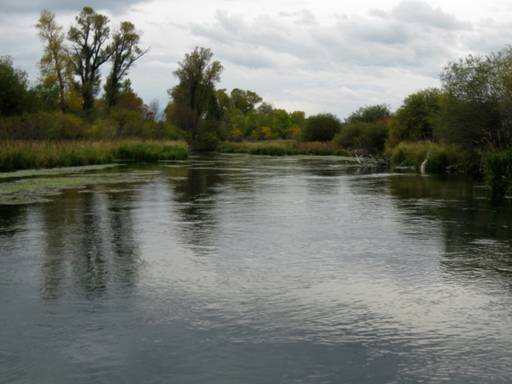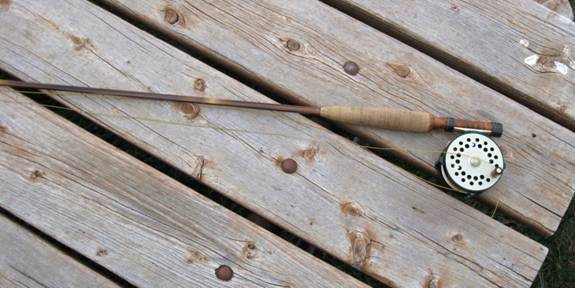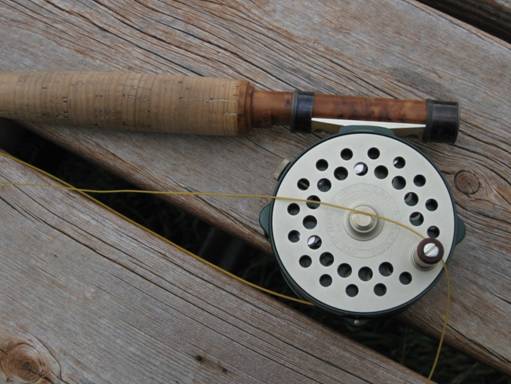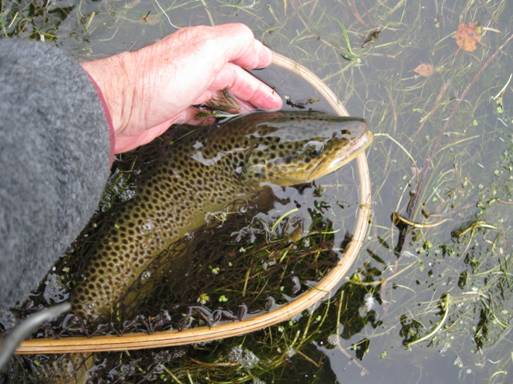FALL BAETIS
Low clouds obscure the tops of the mountains, there is a hint of rain, and the wind sliding down from the north sends a shiver through my frame. Ah, it’s a perfect fall Baetis day.
Each fall I look for that one perfect day when I know from past experience that the conditions are right for a major hatch of fall Baetis mayflies on my favorite spring creek. Baetis mayflies are a very important hatch on many trout waters from the east to west. They are a multi-brooded insect which means that an individual species may have more than one hatch of adults during the course of the year. Baetis are one of the first major mayfly hatches in the spring on many trout streams and they are also the last major mayfly hatch on those same streams in the fall. Most of the Baetis species are small - #18 - #24 – and are commonly called Blue-Winged Olives by fly fishers. As an angler that loves to fish small imitations to selectively feeding trout this is my kind of hatch.
I have many vivid memories of fishing the fall Baetis hatch. A number of years ago we had been enjoying a long, warm fall. Except for a couple partly cloudy days there had only been a smattering of Baetis and I was wondering if we were going to get a prefect Baetis day. When I had nearly given up hope of a good day of Baetis fishing the weather forecast called for a change in the weather. In those days I was still “gainfully employed” as a judge, but the weather change was slated for the weekend. Perfect.
Saturday was a continuation of the sunny warm weather that we had been experiencing all fall, but when I rolled out of bed on Sunday morning the clouds completely obscured the mountains. Stepping outside on my way to church I realized that I should step back inside and get a warmer jacket. Unless I missed my bet today would be a fall Baetis day.
When we exited the church building at noon the clouds were even thicker and it was beginning to sprinkle a bit of cold rain. We hurried home and I changed clothes while my wife prepared lunch. With lunch behind me I kissed her good-bye, jumped in the old fishing car and was on my way to my favorite spring creek. By the time I arrived the light rain had turned into a full blown downpour driven by a strong east wind. As I crossed the creek a quick glance upstream revealed a full blown hatch was in progress.
I backed the fishing car up to the door of the fisherman’s hut and quickly unloaded my gear inside. Before I put on my gear I started a fire in the wood stove so that I would have a warm, dry place to retreat into when the weather started to get to me. Within a few minutes I was waist deep in the stream with a blanket hatch of fall Baetis and rising trout all around me. With the east wind to my back I dropped my fly to the closest riser and immediately I was into a fine spring creek trout. After about an hour of fishing I retreated to the fisherman’s hut to warm up and while I sat warming my hands I noticed that it was beginning to snow. The flakes were large and wet and soon the grass and the bare ground were covered, but the Baetis continued to hatch and the trout continued to eat them. Finally, chilled to the bone, I called it an afternoon. I don’t know how many fish I hooked and released but I covered less than 10 yards of the stream during the time that I fished. Now that’s a fall Baetis day!

This year my perfect Baetis day came just a few days ago. The weather was much more hospitable than that day several years ago, but still it had all the required ingredients. I left the house about 1 P M and when I arrived at the creek I was greeted by a cloud of Baetis spinners dancing over the surrounding meadows and streamside trees. A quick check of the stream told me that a good hatch of fall Baetis was underway.


I had decided earlier that if I had an opportunity to fish the fall Baetis this year that I would make it a ‘traditional day’; bamboo rod, Hardy reel and silk line. I have a 7½ foot Ron Kusse Quad that I had not fished before, a nice Hardy Bougle reel, and a double tapered Phoenix 5 weight silk line. I had to use a conventional nylon leader since I was completely out of suitable drawn gut. [Like I have ever used a gut leader – bamboo and silk are about as traditional as I can get]
I started out with a size #22 dark Baetis comparadun with a trailing shuck attach to a 9 foot leader with a 5x tippet. The hatch was heavy, the trout were very interested, and I promptly missed the first three fish that took my fly. The fourth fish I hooked was a nice rainbow that promptly ran me through the weeds and then went airborne before I could get him under control. He added my comparadun to his fly collection.

Now I had some idea of the fishing qualities of the Kusse Quad I settled down and started hooking and actually netting some fish. First fish to the net was a nice male brown trout. He was well hooked in the corner of the jaw, the evidence of a confident take. He was followed by several more browns and one nice rainbow.
I noticed that some of the fish were not taking the duns but were taking the nymphs a couple inches below the surface so I attached a #22 pheasant tail nymph on a dropper about six inches behind my dry fly. This produced several more takes. At the head of the run that I was fishing I had been watching a real nice fish wallowing around taking fly after fly. I fished my way upstream until I was within casting range. Just as I laid down a cast he rose and I dropped the line right across his back. He took umbrage at the indignity. Judging from the distance between his nose and dorsal fin I believe he was well over 20 inches.
The hatch began to slow after about two hours and then sputtered to a halt. After any heavy hatch there are always a few stray flies that continue to hatch and the occasional cripple that got tangled up in the weeds, and a few fish continued to rise sporadically to the stragglers. I could have tried to fool a few more but it had been a good day and I was satisfied to allow the few remaining risers to continue to feed unmolested.
During the course of the hatch I fell in love with the Kusse Quad. The rod cast flawlessly and with pinpoint accuracy. The rod is fast and once I slowed down I was able to consistently hook the trout that rose to my fly. Once hooked the rod had plenty of backbone to allow me to effectively fight the fish and get them to the net for release. It was a perfect fall Baetis day, and I was blessed to be able to fish it one more time.
